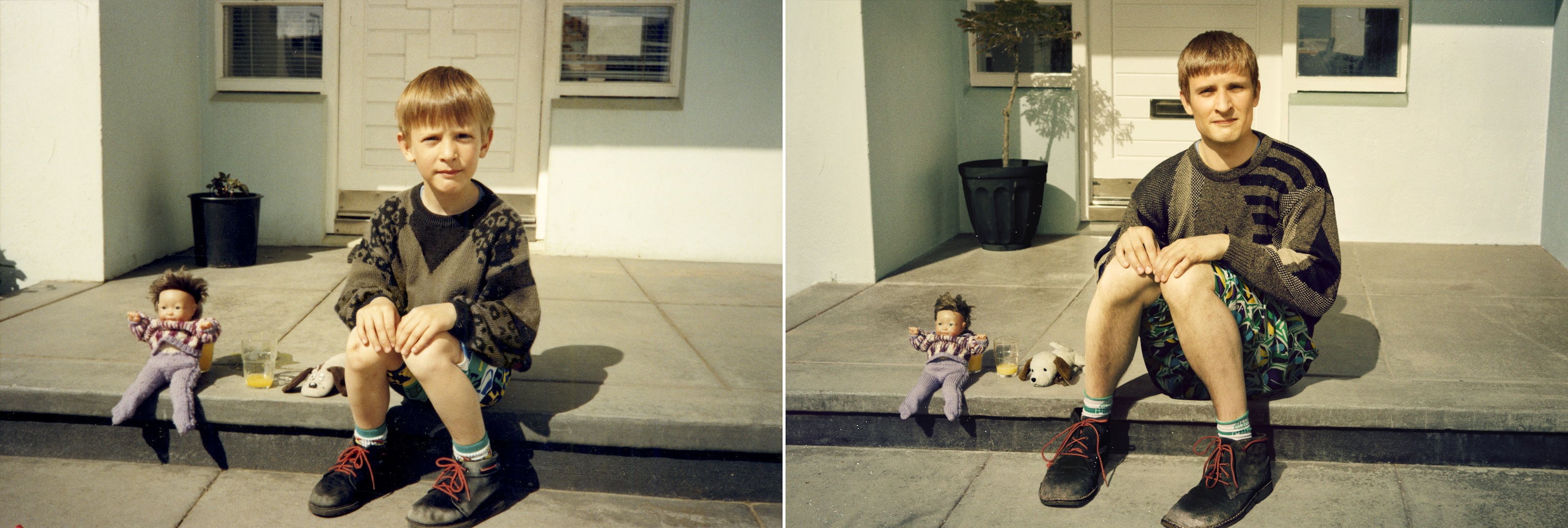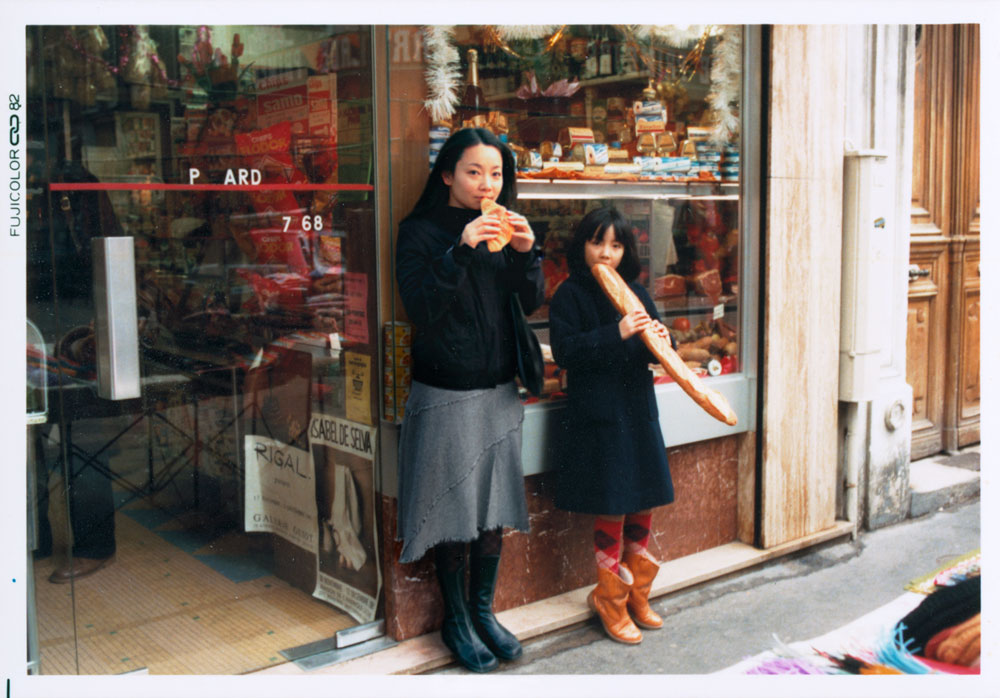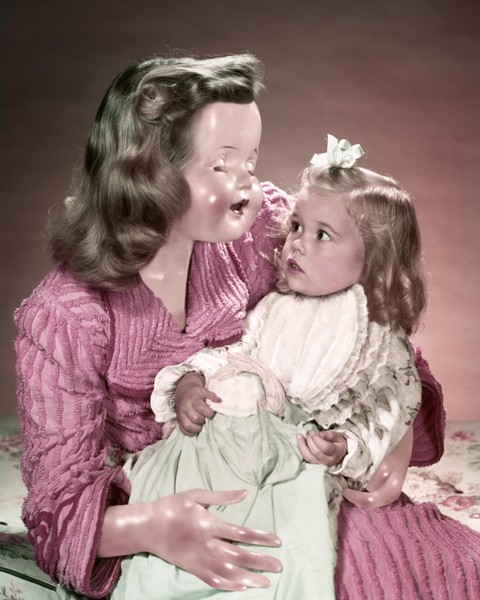During the summer it is important that you keep training your eye and practice making images. Below are two task COMMUNITY (photo-assignment) and another FAMILY ARCHIVE (research) that you can work on during the summer break which will prepare you for the next academic year in September.
Publish all your work on the blog before returning to school on Tue 7 September. Best of luck!
PHOTO-ASSIGNMENT: How might you represent the best aspects of the community you belong to – or even set out to develop a stronger sense of community via photography?
You can either decide to continue to revisit an area of St Helier that represents a migrant community or approach this photo-assignment in a new way that is linked more directly to your own community of where you live.
Imagine you were the official photographer of your street, neighbourhood, town or city. You have been commissioned to create a sequence of photographs celebrating the spirit of this place and its people. These images will be published in various forms – in a free newspaper, on posters in bus shelters, on postcards , on advertising hoardings etc. You are limited to 10 pictures in total. Make a larger body of images, then edit these down to just 10. Arrange in a sequence or collage. What story do they tell? What are the challenges of an activity such as this and how might you set out to overcome these?
There are different approaches to how photographers work with a community. Either as a outsider looking in or as an insider who is part of that community. The best work often emerges from photographers who work with a social group that they are familiar with or have a personal connection to. A community can be defined as a group of people who share the same values, cultural codes and perform certain social rituals. This group could be family and friends or an estate or a neighbourhood. It could be a recreational activity or a sport.
BLOG > PHOTO-ASSIGNMENT
- Produce at least 3 photo-shoots!
- Review and evaluate your shoots as they develop
- Identity weaknesses and strength
- Plan and re-visit for a new shoot that adds value to what you already have.
You have to ask yourself:
Am I satisfied that I have enough images/ material?
What are you going to do differently on next shoot?
How are you going to develop your ideas?
These images could become part of Personal Study that we will develop later in the autumn term. You could produce another photo-zine based on this summer project and any work that you produce will be assessed as part of your Personal Investigation (coursework) awarding you marks based on skills, knowledge and understanding of photography as a tool for communication in narrative, sequence and design.
INSPIRATION: IN PROGRESS
IN PROGRESS: Laia Abril – Hoda Afshar – Widline Cadet – Adama Jalloh – Alba Zari at the RPS Gallery (20 May – 31 October 2021) commissioned by the RPS as part of Bristol Photo Festival. They are designed with students in mind, particularly visitors aged 11 to 18. However, they can be enjoyed by all and easily adapted for a younger (or older) audience.
The Royal Photographic Society is an international educational charity committed to bringing photography to everyone. Founded when photography was in its infancy in 1853, today the RPS is a world-leading photographic community with a membership of 10,700 photographers worldwide. The RPS Gallery is situated in the photography hub at Paintworks, Bristol, UK.
This exhibition is a celebration of contemporary photography at its most diverse, dynamic and progressive. Five distinct solo exhibitions are presented together. Aaron Schuman, the curator, has selected these photographers to collectively represent some of the varied and exciting approaches being taken towards photography now.
Contemporary photography often involves an “expanded” practice – ways of thinking, making and presenting that extend beyond established disciplines and photographic traditions to more fluid and responsive ways of working. Contemporary artists may have a critical or questioning attitude to photography and its histories – a less dogmatic, not-so-fixed understanding of what it means to be a photographer. Contemporary photographers can also be excited by new modes of production and distribution, and new ways to tell their stories.
The images on show in this exhibition provide some clues about the direction in which photography is travelling. It makes for a fascinating show for young creatives to explore and respond to.
CONTEXTUAL STUDIES: Produce a blog post where you REVIEW the exhibition IN PROGRESS and consider the following:
- What does the title ‘In Progress’ suggest about the nature of the work on show?
- What connotations does the word ‘progress’ have for you?
- In what ways do you think photography has changed in the last 5 years? What new concerns, agendas, or motivations might contemporary photographers have now, or in the near future?
- What are/were your expectations for this exhibition? What are your expectations for any exhibition of photography? Are there certain images, themes or ways of presenting that you would expect to encounter? In what ways might this exhibition support or contradict your expectations?
EXTENTION: ARTISTS REFERENCES
Produce an in-depth study of one of the artists in the exhibition Laia Abril, Hoda Afshar , Widline Cadet, Adama Jalloh or Alba Zari.
LAIA ABRIL: On Menstruation Myths
“Are you sick?” I remember being asked when I was a teenager. People were questioning whether or not I was on my period. Even though I wasn’t supposed to exercise or swim —or apparently make mayonnaise; I never actually perceived those myths as affecting my daily life. However, I remember learning that society had mandated that getting my period should remain a secret. The same ritual that was supposed to symbolize that I had “become a woman,” came with an unbearable pain that was normalised. — Laia Abril

Abril’s work ‘On Menstruation Myths’ is a chapter of a larger body of work entitled ‘A History of Misogyny’. The artist explores the misunderstandings, silences, miseducation and physical pain associated with menstruation. Abril admits to having found the subject of menstruation personally embarrassing. She asks questions about what it means to be a woman, why menstruation is a source of shame, why some young women are denied their basic rights and why myths about menstruation have such deep cultural roots. Abril deliberately creates aesthetically appealing images in order to persuade viewers to spend time with them and read the accompanying text. It is important to her to have both men and women see the work since menstruation is a human rights issue. The combination of blue and red is a kind of visual game since, for many years, advertisers of sanitary products chose blue, rather than red, to indicate menstrual blood. Abril searches for appropriate visual metaphors that synthesise her ideas and arouse curiosity.
For discussion:
- What kind of research has the artist done in order to explore this subject?
- Why is the subject of menstruation such a source of embarrassment and shame?
- What challenges might the artist have faced in choosing to make images about menstruation?
- How has the artist chosen to visually present a potentially alienating subject? Which of these do you find most intriguing, appealing, uncomfortable, effective or informative?
- What are the potential advantages or disadvantages of tackling (addressing, representing, depicting) a subject indirectly – using objects or associated images as visual metaphors or representations?
- Do you think photography has the power to educate and change both opinions and public policy? Can you think of alternative examples where this has happened? What issues or injustices might your own photography explore or address?
- Have your views or knowledge of menstruation been altered by seeing this work?
Hoda Afshar: Agonistes
The whistleblower is the modern tragic figure in our current society. For me it was about the character, not the individuals, it was about their actions, and at the heart of it, there was something that reminded me of the Greek tragedies. That’s why I chose the title Agonistes, because this is a Greek word that means personal injury and an inner struggle.
— Hoda Afshar
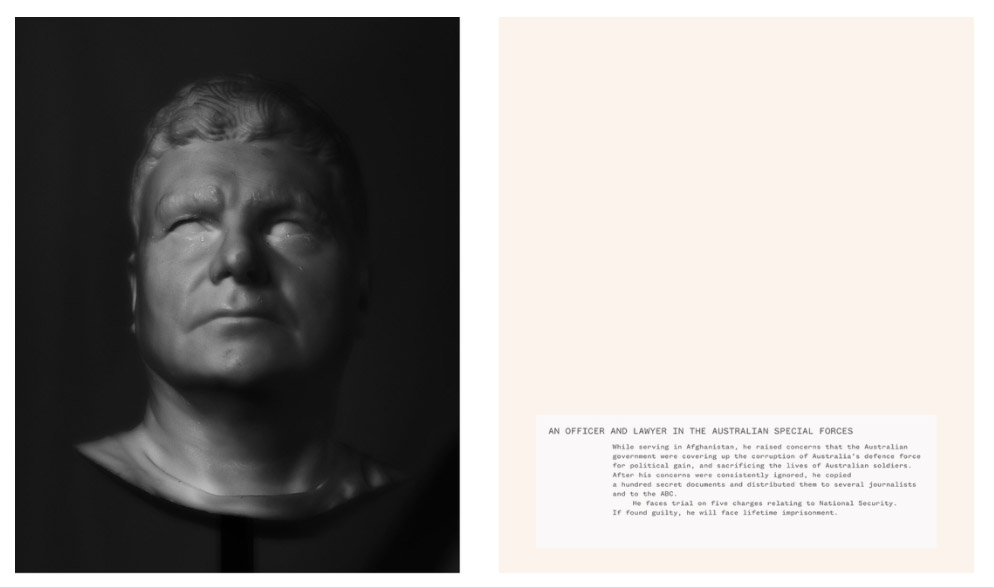

For discussion:
- Why do you think Afshar chose not to photograph her subjects directly? What risks are involved for both photographer and subject in this project?
- What role does research play in Afshar’s practice?
- Why might a contemporary photographer using new technologies choose to reference ancient ideas and methods of working?
- In what ways do Afshar’s photographs (of 3D-printed portraits) compare or differ from ancient-classical Hellenistic sculptures?
- What do you notice about the way the sitters are filmed in the accompanying video?
- Why is the accompanying text (caption) for each picture so important?
- Why do you think the artist was so fascinated and troubled by the fate of these whistleblowers? What issues does she expose through the exhibition of these images?
- Have you ever spoken-out regarding an injustice to others; shared a wrong-doing with the hope of positive repair and action? If so, how did you feel? And how would you then feel about being photographed and presented in an exhibition? Why might someone choose to photograph you for this?
Widline Cadet: Seremoni Disparisyon (Ritual [Dis]Appearance)
Most of the photographs are of Black women and greenery and these abstract landscapes.
— Widline Cadet
Widline Cadet was born in Haiti and lives in the United States. Her work explores cultural identity, race, memory and immigration through photography, video and installation. ‘Seremoni Disparisyon (Ritual [Dis]Appearance)’ is a series of self-portraits, sometimes featuring Cadet but also using friends and family to stand in for her. Female figures are placed in natural settings. Repetitive gestures, shapes and props tie the images together. Backdrops, poses and an element of abstraction remind us of the constructed nature of photographic images. The pictures are suffused with a warm glow, an idyllic sense of calm and graceful positivity. Women support one another, literally and metaphorically.
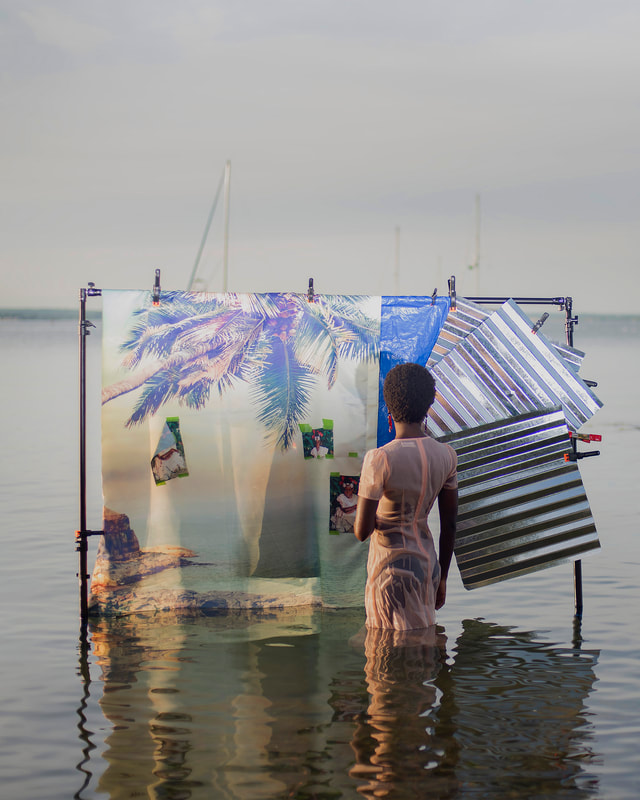

For discussion:
- “Serious hopefulness” is a phrase Cadet has used to describe the intention behind her photography. What does this phrase suggest to you? Can you see evidence of this combination of seriousness and hope in her images? Is it possible to identify specific aspects – subjects, gestures, interactions, relationships, expressions, colours, and so on – that might be considered more (or less) serious or hopeful? Are black and white photographs more serious and/or less hopeful than colour images?
- How would you describe the relationship between figures and landscapes in these photographs?
- The title of this series of photographs is quite complex. What does it suggest to you? What types of ritual are presented in the pictures? What or who is both appearing and disappearing?
- When a person’s face is concealed (or part-concealed) within a photograph, what possibilities (or problems) can arise for the viewer? Does this concealment have the potential to provoke more (or less) intrigue, mystery, empathy or emotion?
- How and where would you choose to represent yourself through photography? If you had to choose someone else to stand-in as a representation of you, who would you choose and why?
Adama Jalloh: Process
Street photography has trained my eyes and my ears […] even if I haven’t seen something, if I hear it that’s when I’m preparing to take a shot […] it’s interesting how my body reacts to certain things, how alert I am
— Adama Jalloh
Jalloh describes her photographs as ways to keep memories alive. She grew up in south London and makes photographs on the street. She explores cultural traditions, religious beliefs, clothes and hair styles, sensitively drawing attention to intimate moments and relationships. Jalloh appreciates her local environment, documenting the lives of ordinary citizens, creating (over time) a rich archive of everyday interactions. These images are a way to create a collective memory bank of moments, a love story about belonging, charisma, survival and joy in the city. Jalloh’s photographic memories belong to the whole community. It’s important for her to bond with her subjects. Jalloh is an insider (to borrow Abigail Solomon-Godeau‘s term), a trusted witness rather than a cultural tourist. She collaborates with her subjects, allowing them to present version of themselves to her camera without judgement.
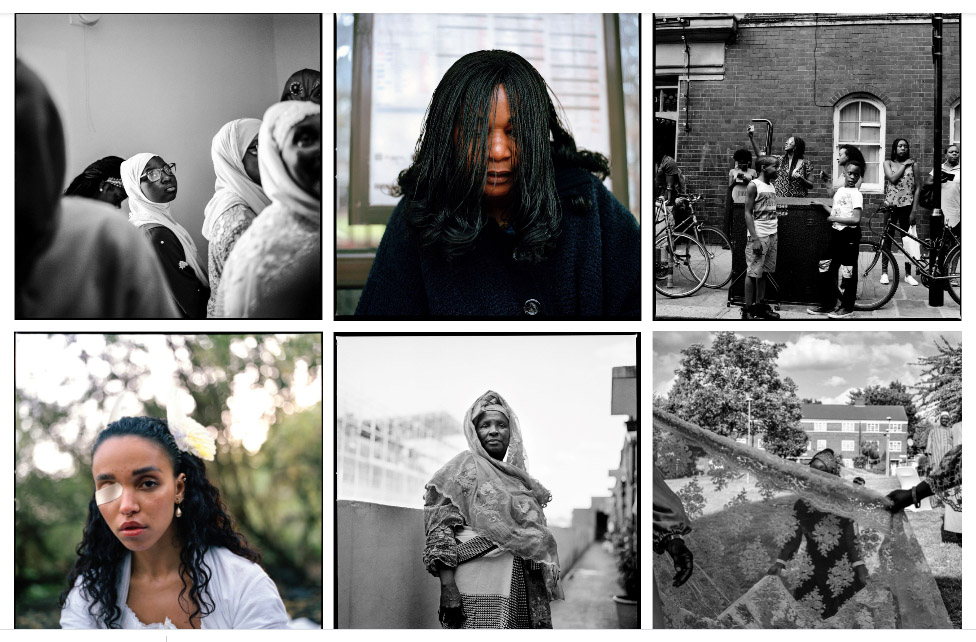
For discussion:
- Jalloh uses the word “intimacy” a lot to describe the quality of her images. In what ways are her photographs intimate? What other qualities do they have?
- How reliable are photographs in conveying the experience of a photographer in a particular moment? Can photographs evoke particular – or new – sensations, sounds, smells, tastes, emotions or anxieties?
- How does photography help to develop our understanding and appreciation of places and people, known and unknown?
- What kind of person comes to mind when you think of a street photographer? How does Jalloh challenge/confirm this stereotype?
- What skills or personal qualities do you need to be a street photographer? How might these skills vary when in different cities, countries or cultures?
- What (if anything) distinguishes a ‘street photograph’ from other images taken in the street, such as a photograph of a building, or a person posing for camera?
- Why do you think the majority of Jalloh’s images are black and white? What are the advantages or disadvantages of photographing in black and white?
Alba Zari: Occult
I don’t think about photography as a “I have a camera; I will shoot some pictures because…”. Sometimes I see someone that looks interesting and think “I’d like to take some pictures of them” but I don’t bring my camera with me. I think photography is like a story, a concept, so if I find an interesting story I write and research before shooting it.

Zari was born in Bangkok and has studied in Italy and the USA. Her current project ‘Occult’ tells the story of The Children of God, originally a hippy cult from the California of the late 1960s which has now spread across the world. The cult believes in ‘free love’ but this includes instances of the sexual abuse of children, incest and prostitution. Zari’s grandmother and mother were both members and she was born into the cult. Her research has taken place in London but she intends to travel to shoot the images in Berlin, India and Thailand. The work draws on her family archive, propagandist comics, texts and videos, and archive images of other members of the sect taken from the internet. Zari assembles fragments of text and images, clues to a larger narrative. She investigates the cult’s propaganda machine, contrasting the public image of belonging, joy and faith with the story of one family’s troubling experiences. She also draws attention to the fate of other women and children outside her own family. Zari reveals the capacity of photographs to tell lies but how they can also be made to reveal the truth. The combination of text and image is central to the work.

For discussion:
- Zari’s practice is rooted in both personal experience and research. What are the potential problems, advantages or disadvantages of this combination? How objective – not influenced by personal feelings or opinions – should (or can) research be?
- How does Zari combine archival material with images she shoots herself? What kinds of stories does she tell? Which of her images, above, might you consider the most reliable or truthful? What words help to explain some of the differences between these images and approaches?
- How would you describe Zari’s attitude to the medium of photography?
- How accessible – easy to understand or connect with – are these selected images, above? How does encountering them as a collection influence your understanding or experience? Do they appear fragmented, like pieces of a jigsaw puzzle? How might the sequence, scale or context in which you encounter them alter your interpretation? (Note: the images above have been selected from available online resources and organised here by PhotoPedagogy rather than the artist).
Some suggested activities:
NOTE: The activities within this resource are designed to be accessible for all and therefore can (mostly) be completed with basic art materials and a digital camera.
- Gather, review and research a selection of photographs that are meaningful to you. They could be pictures you admire, pictures from a family album, photographs of friends, favourite images you have made and look at regularly. What stories do they tell about you, directly or indirectly? How might you make this collection more – or less – truthful or peculiar? How might you present these in a playful or profound way, for example, using various scales; concealing or revealing aspects; adding accompanying texts? How might you share these pictures with others – a slideshow, a film, an exhibition or a zine/book, for example?
- What would you like to understand better (and how might photography help you to do this)? Make a list of topics/issues that you find mysterious, troubling, urgent … but which you know little about. Do some research and make a dossier of your discoveries. Once you have amassed some information in various forms (photocopies, notes, lists, links to videos, printed images etc.) try to make some photographs of your own. You may decide to stage these images, filling in the gaps and inventing scenarios that don’t already exist. Alternatively (or additionally), you might attempt to document aspects of the story, capturing evidence of the issue you have researched in the real world.
- Experiment with making a series of self-portraits in which you don’t always personally appear. Look again at the work of Widline Cadet. She sometimes uses friends and family members to stand in for her. You could try this too. But how else might you represent yourself? Consider using objects (props), settings (backdrops), lighting, costumes and other theatrical devices to present a (fictional) version of you. You might wish to experiment with old photographs of you as a child, manipulating, disrupting and/or re-presenting them in some way. How can you convey a sense of who you are without relying on a conventional self-portrait?
- How might you represent the best aspects of the community you belong to – or even set out to develop a stronger sense of community via photography? Imagine you were the official photographer of your street, neighbourhood, town or city. You have been commissioned to create a sequence of photographs celebrating the spirit of this place and its people. These images will be published in various forms – in a free newspaper, on posters in bus shelters, on postcards , on advertising hoardings etc. You are limited to 10 pictures in total. Make a larger body of images, then edit these down to just 10. Arrange in a sequence or collage. What story do they tell? What are the challenges of an activity such as this and how might you set out to overcome these?
- Re-tell in photographs a story or scene remembered from your childhood. Adama Jalloh sometimes finds scenes in her everyday life that remind her of her childhood. You may be able to do something similar, perhaps revisiting childhood locations that are meaningful to you. Alternatively, you could re-enact through staging (collaborating with relatives or friends) a childhood memory. You might even take part in this yourself, directing (rather than taking) the photograph. You could experiment with using different types of text as captions or accompanying information. You might choose to revisit a street, park or area of personal significance, or perhaps reconnect with an old friend or family member.
- Stage a collaborative pop-up exhibition. How might you team up with classmates, friends or even family members to present a group show? What shared or distinct ideas might you bring together? Where might be an appropriate – or unexpected – place to exhibit your collective efforts? Rather than worrying about expensive framing or gallery-like spaces, consider easily accessed environments and existing resources, such as displaying within classroom or corridor spaces or floors, or upon outside walls, fences, benches or washing lines. Beyond working as artists and photographers to prepare, what other skills and roles might you need to embrace? How might your exhibition be a force for good, or positive change or connections, within or beyond your group of friends, family, school or community?
FAMILY ARCHIVES: Explore your own private archives such as photo-albums, home movies, diaries, letters, birth-certificates, boxes, objects, mobile devices, online/ social media platforms and make a blog post with a selection of material that can be used for further development and experimentation using a variety of re-staging or montage techniques .
Archives can be a rich source for finding starting points on your creative journey. This will strengthen your research and lead towards discoveries about the past that will inform the way you interpret the present and anticipate the future. See more Public/ Private Archives
For example, you can focus on the life on one parent, grand-parent, family relative, or your own childhood and upbringing. Ask other family members (parents, grand-parents, aunties, uncles) if you can look through their photo-albums too etc.
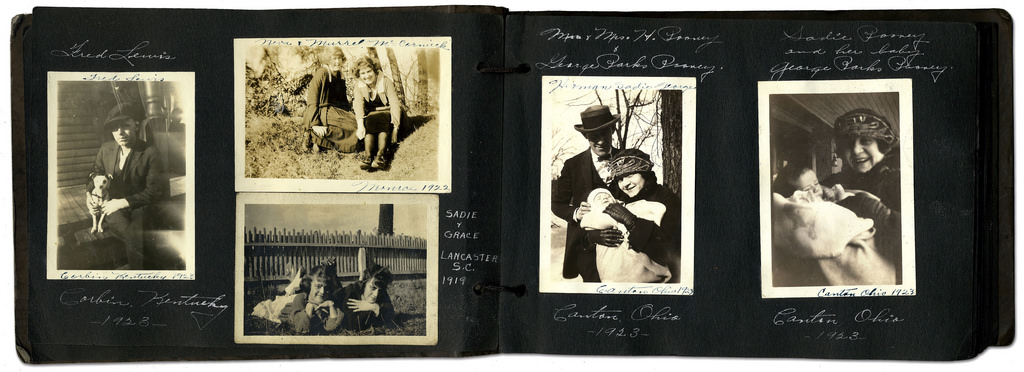

TASKS STEP-BY-STEP GUIDE:
- Either scan or re-photograph archival material so that it is digitised and ready for use on the blog and further experimentation.
- Plan at least one photo-shoot and make a set of images that respond to your archival research. This can be re-staging old photos or make a similar set of images, eg. portraits of family members and how they have changed over the years, or snapshots of social and family gatherings.
- Choose one of your images which relates to the theme of family (e.g. archive, family album, or new image you have made) and destroy the same image in 5 different ways using both analogue and digital method techniques. Eg. Reprint old and new photos and combine using scissors/ tearing and glue/ tape. In Photoshop use a variety of creative tools to cut and paste fragments of images to create composites.
Extension: Choose a second image and destroy it in 5 new or other ways.
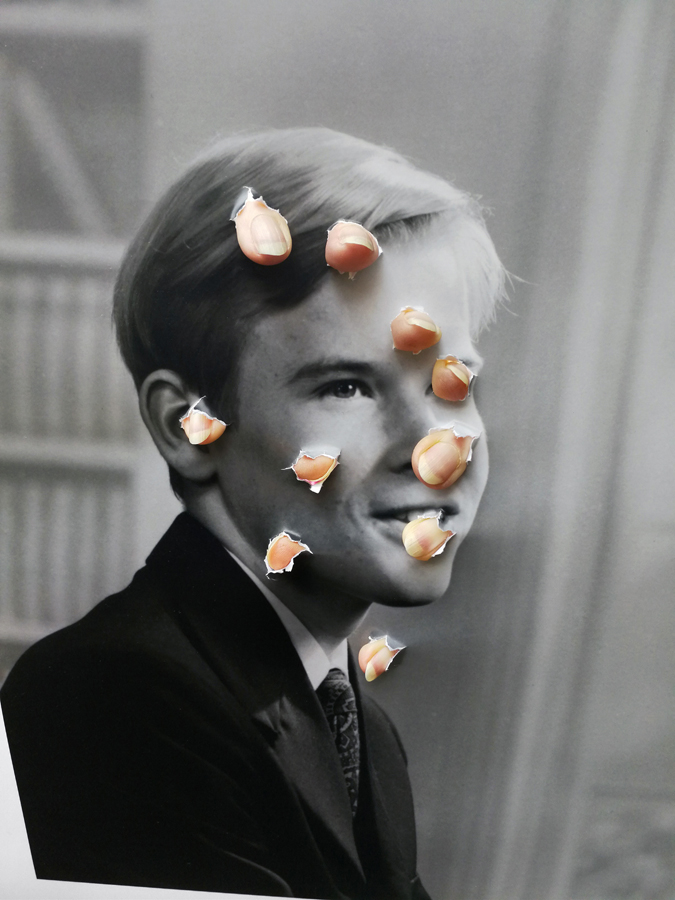
cof 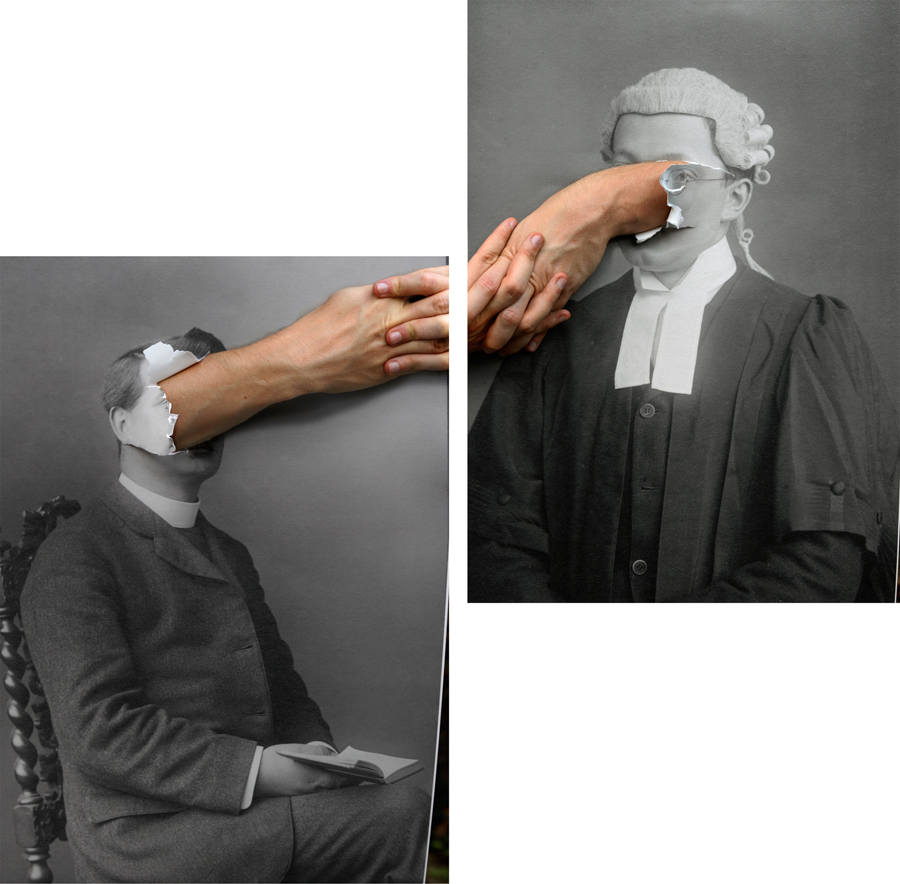
Under Oath, 2017
Jonny Briggs: In search of lost parts of my childhood I try to think outside the reality I was socialised into and create new ones with my parents and self. Through these I use photography to explore my relationship with deception, the constructed reality of the family, and question the boundaries between my parents and I, between child/adult, self/other, nature/culture, real/fake in attempt to revive my unconditioned self, beyond the family bubble. Although easily assumed to be photoshopped or faked, upon closer inspection the images are often realised to be more real than first expected. Involving staged installations, the cartoonesque and the performative, I look back to my younger self and attempt to re-capture childhood nature through my assuming adult eyes.
Thomas Sauvin and Kensuke Koike: ‘No More, No Less’
In 2015, French artist Thomas Sauvin acquired an album produced in the early 1980s by an unknown Shanghai University photography student. This volume was given a second life through the expert hands of Kensuke Koike, a Japanese artist based in Venice whose practice combines collage and found photography. The series, “No More, No Less”, born from the encounter between Koike and Sauvin, includes new silver prints made from the album’s original negatives. These prints were then submitted to Koike’s sharp imagination, who, with a simple blade and adhesive tape, deconstructs and reinvents the images. However, these purely manual interventions all respect one single formal rule: nothing is removed, nothing is added, “No More, No Less”. In such a context that blends freedom and constraint, Koike and Sauvin meticulously explore the possibilities of an image only made up of itself.
Veronica Gesicka Traces presents a selection of photomontages created by Weronika Gęsicka on the basis of American stock photographs from the 1950s and 1960s. Family scenes, holiday memories, everyday life – all of that suspended somewhere between truth and fiction. The images, modified by Gęsicka in various ways, are wrapped in a new context: our memories of the people and situations are transformed and blur gradually. Humorous as they may seem, Gęsicka’s works are a comment on such fundamental matters as identity, self-consciousness, relationships, imperfection.
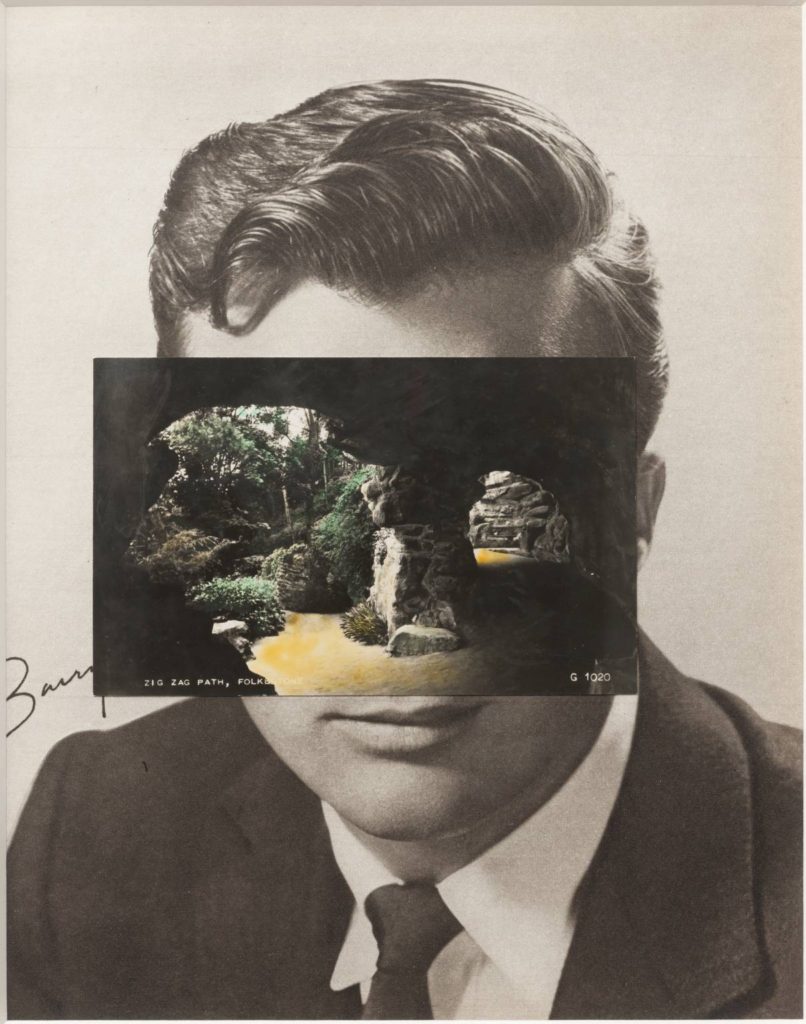
John Stezaker: Is a British artist who is fascinated by the lure of images. Taking classic movie stills, vintage postcards and book illustrations, Stezaker makes collages to give old images a new meaning. By adjusting, inverting and slicing separate pictures together to create unique new works of art, Stezaker explores the subversive force of found images. Stezaker’s famous Mask series fuses the profiles of glamorous sitters with caves, hamlets, or waterfalls, making for images of eerie beauty.
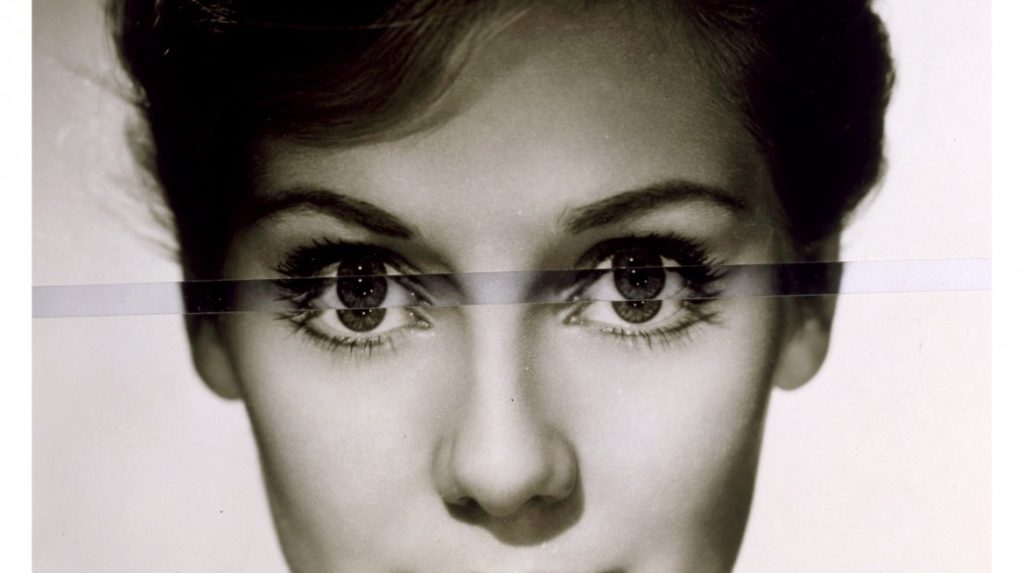
His ‘Dark Star’ series turns publicity portraits into cut-out silhouettes, creating an ambiguous presence in the place of the absent celebrity. Stezaker’s way of giving old images a new context reaches its height in the found images of his Third Person Archive: the artist has removed delicate, haunting figures from the margins of obsolete travel illustrations. Presented as images on their own, they now take the centre stage of our attention
There are different ways artists and photographers have explored their own, or other families in their work as visual storytellers. Some explore family using a documentary approach to storytelling, others construct or stage images that may reflect on their childhood, memories, or significant events drawing inspiration from family archives/ photo albums and often incorporating vernacular images into the narrative and presenting the work as a photobook.
Rita Puig-Serra Costa (Where Mimosa Bloom) vs Laia Abril (The Epilogue)> artists exploring personal issues > vernacular vs archival > inside vs outside

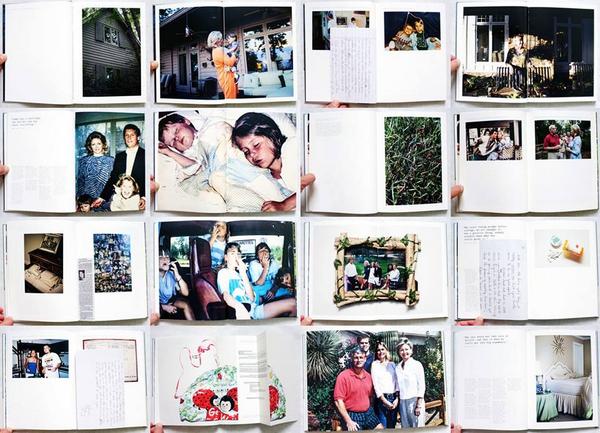
Carole Benitah (Photo Souvenirs) vs Diane Markosian (Inventing My Father) > family > identity > memory > absence > trauma
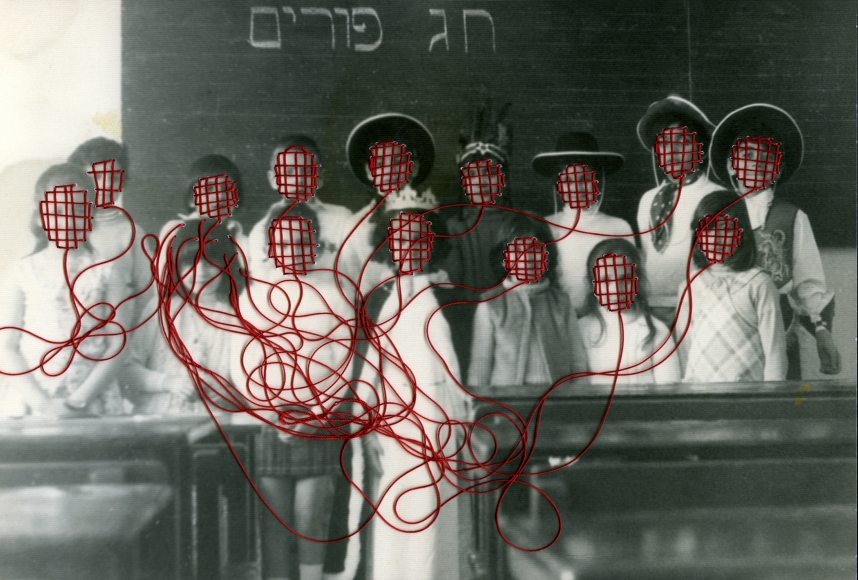

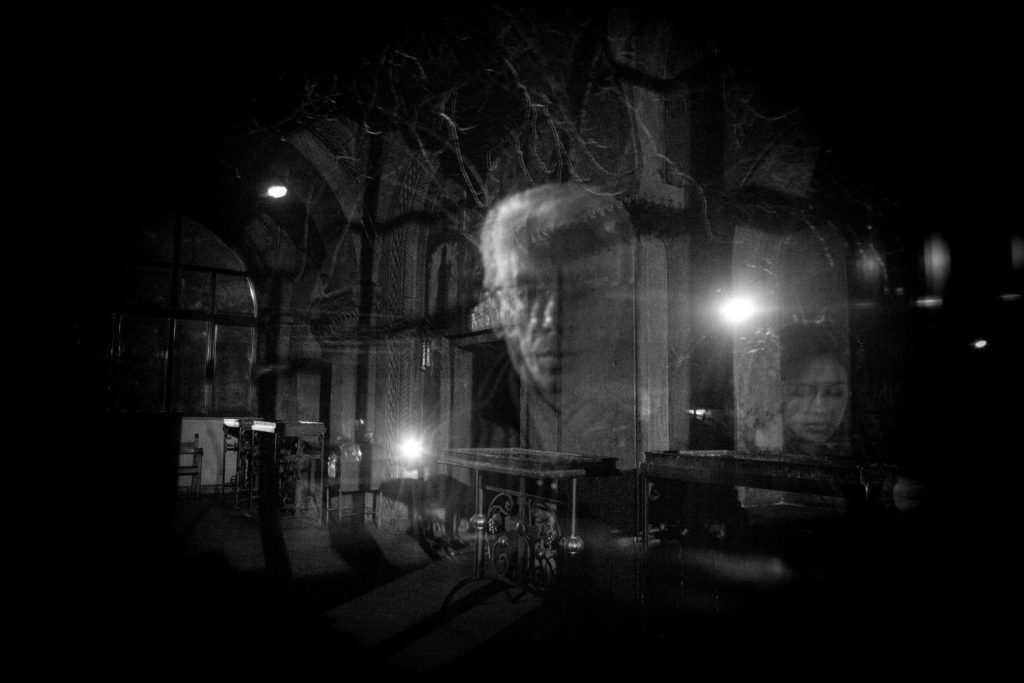
Ugne Henriko (Mother and Daughter) vs Irina Werning or Chino Otsuka > re-staging images > re-enacting memories

Read article in The Guardian
